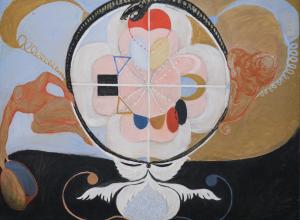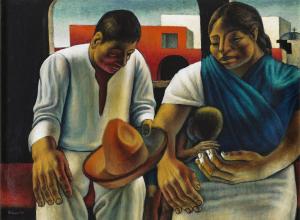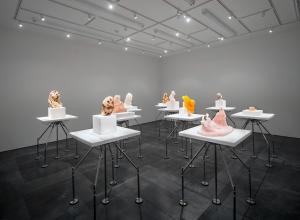
It’s Greek to me


It’s Greek to me
The ancient world of Greek design comes to life in this suite of Byzantine-inspired gold and gem-set jewelry by Ilias Lalaounis. The 18k gold suite includes a bold, rigid bib collar, a pair of matching hoop earclips and a wide band. The suite was sold for $16,250, more than double the high estimate.
The warm color of 18k gold is a perfect backdrop for the rich colored gemstones, each set within its own raised collar. The textured background is created by hand hammering the gold to achieve this ancient look. The many angled planes add even more warmth to the metal. The collar is set with round sapphires, rectangular-cut emeralds, and cabochon rubies, alternating in sections across the surface. The hoop earrings are set with rubies and emeralds while the band is set with a square-cut sapphire and cabochon rubies and emeralds.
The choice of red, green and blue gems gives this suite universal appeal as well as the facility to complement nearly any type of clothing. The design is both striking yet tailored, since the gems are set in strictly ordered rows, and placed within the formal constraints of the bezels that hold them securely in place.
Lalaounis was a fourth generation jeweler, born in Athens where he lived and worked throughout his long life. He sought to bring traditional and ancient Greek jewelry techniques and motifs into the modern era. He successfully did this by taking inspiration from the past—Classical, Hellenistic and Mycenaean art and architecture–and interpreting it for the modern woman. He lived and worked in an atmosphere of Greece’s historic past, with a shop at the foot of the Acropolis. Inspiration was everywhere, but it was his ability to adopt, transmute, and breathe new life into the designs from the past that resulted in a unique collection of wearable jewelry.
Gold’s remarkable ability to withstand virtually every form of degradation and remain untarnished creates a singular link to the past. Objects made of gold emerge in all their shining beauty after being in the earth for centuries. Gold’s malleability is both its blessing and its curse. It can be pounded, drawn, molded, and bent into any form the human imagination can conjure up, but that same ability makes it vulnerable to being melted down, and re-formed. In that process, history is often lost. Lalaounis’ jewels give us a modern connection to the historic significance of the jewels of antiquity.
Lalaounis passed along the traditions of his business to his four daughters, the fifth generation to continue the family’s work. The breadth and depth of his work can be seen at the eponymous museum he founded in 1993. There, visitors can view more than 4000 pieces of jewelry and small sculpture created during his 60 years as an active goldsmith.

Tribute to Bacchus
Castellani gold and glass necklace, $52,275, Lot #86
Skinner, Boston
May 15, 2018
The archaeological revival style of jewelry occupies its own era in the history of jewelry and jewelry making. Created circa 1880 by master Italian jeweler Fortunato Pio Castellani, this exquisite gold and glass necklace features clusters of glass bead grapes and gold leaves, suspended from a woven gold chain. Having an impeccable provenance, the necklace can be traced back to the era in which it was made. Given as a gift from Augusta Slade to her niece, Helen Slade Smith, it is believed to have been purchased by Augusta on one of her annual winter trips to Europe.
Each element of the necklace is meticulously worked by hand, including the fine gold wires woven to form the supporting chain. The grape clusters, featuring individually blown glass grapes, are spaced along the chain, interspersed with finely wrought gold leaves. Castellani was part of a goldsmithing family that was renowned for figuring out how the ancient goldsmiths mastered the techniques of granulation and other key aspects of their art. The family began making archaeological-style jewelry in the 1830s, after they were privy to the mysteries of the work found in Etruscan era tombs. Their understanding of how the ancient jewels were made, and their mastery–their very reinvention—of those techniques, put them in the forefront of 19th century jewelry.
Ironically, when the family business ended in 1930, upon the death of Alfredo Castellani, the technique of granulation virtually died with him. It was not until relatively modern times, the 1970s, when it was revived again by contemporary jewelers Jean Stark and Bob Kulicke who taught an entire generation of young goldsmiths to learn and master the technique.
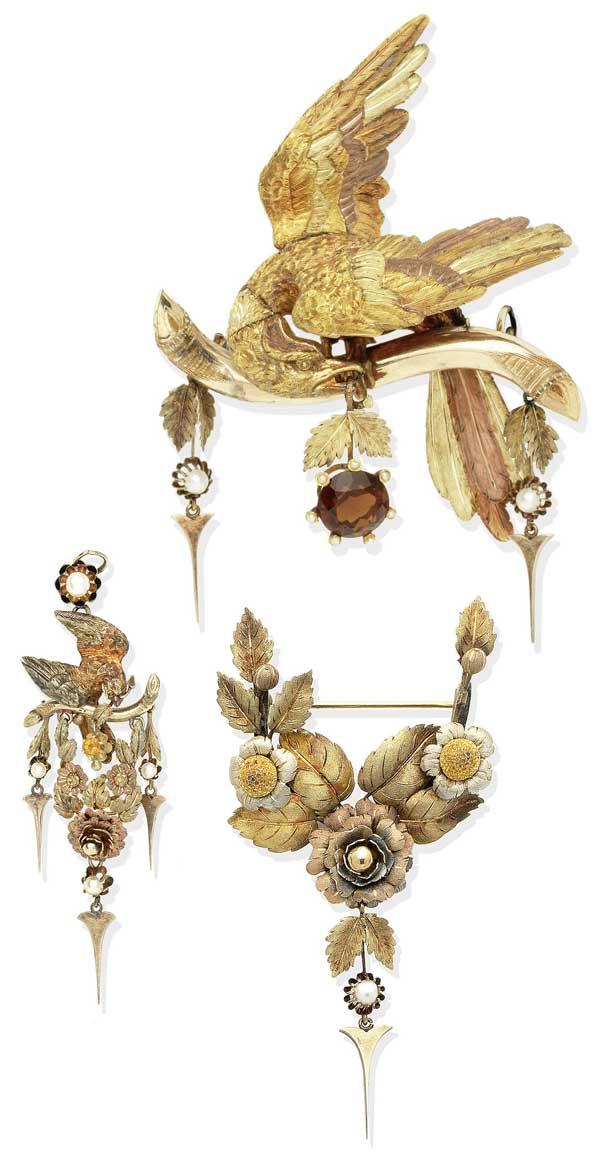
The Eagle has Landed
Antique gold brooch set, $1799, Lot #165
Bonhams, London
July 11, 2018
Continuing the historic jewelry theme, this suite comprises an elaborate tricolored gold and gem-set brooch, a pendant, and a convertible brooch/pendant, all circa 1850. This highly detailed yet delicate three-piece set of jewelry features a realistic eagle that seems to have just landed on a branch, with a round citrine set within seed pearls, and two foliate motifs suspended from the branch. Gems and pearls ornament the other pieces within the set. This highly ornamental style reflects the Victorian era in which it was made.
Various goldsmithing techniques such as chasing and engraving create the richly textured look of the jewels. While gold is always yellow in tone, it is alloyed with other metals to add strength. Subtle changes in color occur during this process, yielding rose, green or white gold tones. Rose gold takes its color from a small amount of copper, while green gold shows the presence of silver. The higher the karatage of the gold, the more yellow it appears. The use of various gold tones here lends a more naturalistic look to jewelry.
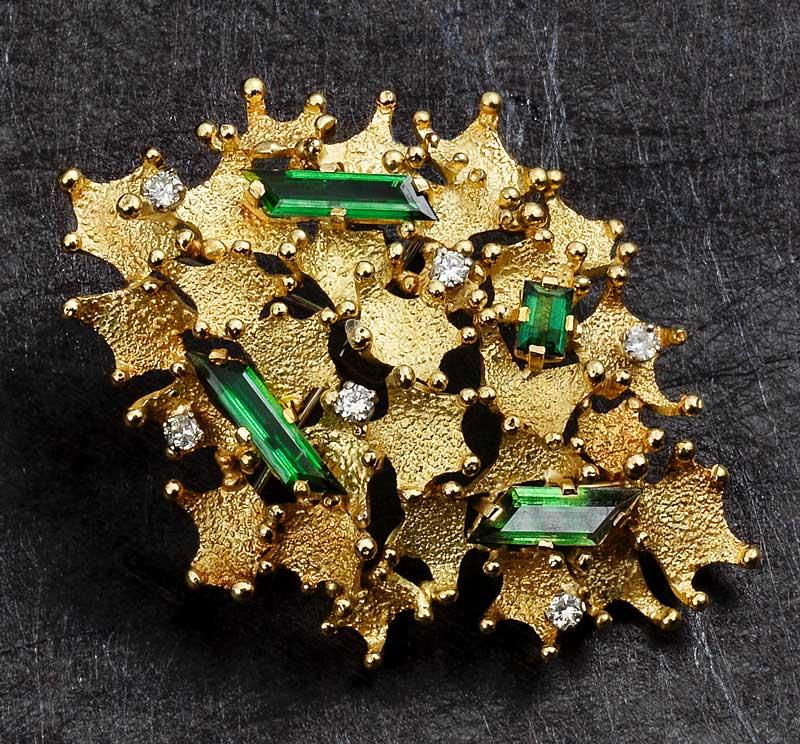
Starry, Starry Night
Tourmaline and diamond brooch, $2,453, Lot #271
Bonhams, London
July 11, 2018
For some, this charming 18k gold brooch, set with diamonds and tourmalines, is just a pretty abstract piece of jewelry. For others, it is an expression of the space race. By 1973, the date this convertible brooch and pendant was created, human beings were living in space for months on end, making it easy to imagine an astronaut watching celestial objects whizzing by. Though described in the catalogue as “abstract,” each textured gold section is modeled as a five pointed star. The diamonds add sparkle to the design while the rich green of the rectangular tourmalines adds considerable interest to the overall design. Tourmalines occur in virtually all colors, and green ones such as these are a fine stand-in for much more expensive emeralds. For those who assign healing properties to certain gems, green tourmalines are highly prized. Though unsigned, the piece does bear a London hallmark.



















